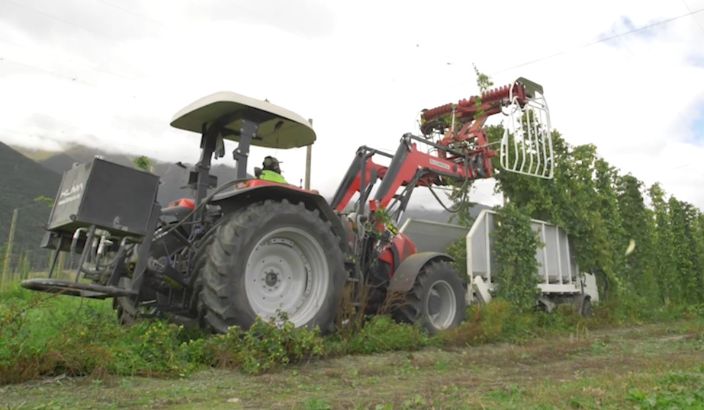End of hop harvest brings optimism in tough global market

Tractor in action, at Nelson Lake Hops, top cutting hops as part of the recent Tasman harvest. Photo: Supplied.
The hop harvest has wrapped up in Tasman, with containers of pelletised hops now on their way to brewers around the world.
While the quality of this season’s crop remains high, growers continue to face pressure from an oversaturated global market.
Hop production surged in recent years, fuelled by the craft beer boom. But with beer consumption slowing, particularly in key export markets, a global surplus has left growers competing harder than ever to move their product.
Despite this, local growers say the season brought some positives.
Colin Oldham, who farms hops in Tapawera and Ngātīmoti, says the market has remained largely unchanged from last season but believes there may be a turning point ahead.
“The market’s been much the same as I expected—still tough—but I do think we’re at the low point.
“Brewers around the world have been working through stockpiles, and now those reserves are lower,” he says.
Colin adds that the growing conditions this year were favourable.
“We had good moisture at the right times, and the warm weather helped. We also had plenty of working backpackers from different countries—labour wasn’t an issue this season.”
Tasman-based NZ Hops, a cooperative of 28 grower-shareholders, noted in its 2025 Post-Harvest Report that their production was scaled back by approximately 25 per cent, including cuts to some of its biggest varieties. At the same time, their production was selectively increased for certain high-performing, in-demand varieties.
Despite the current challenges, there are signs of optimism. A record number of brewers visited Tasman hop farms during this year’s harvest, underscoring continued international interest in New Zealand hops.
Jason Johnson, general manager of Nelson Lake Hops in Murchison, says their season was marked by fast-ripening crops due to drought conditions and an early onset of autumn.
“There was real pressure to get the harvest done quickly, but we had good weather and only lost one day to rain,” he says. “Overall, it was a successful harvest.”
However, the global oversupply has made marketing the product more labour-intensive.
“There’s been a lot more effort required to move hops overseas this year,” Jason explains.
“The market is still oversupplied, but the interest is there—it just takes more work.”
Jason believes New Zealand can remain competitive by focusing on quality and point of difference.
“I think New Zealand needs to stick with producing high-quality, value-added hops to stay competitive—and we’re well placed to do that.
“Global brewers are looking for something to make their beer unique, we can produce a hop that is different from what other countries can produce.”

Colin agrees, adding that New Zealand is known for producing a top-tier product with a great range of varieties.
“Brewers are always after something new with a great aroma. Once global demand levels out, the local hop industry is well-positioned for a strong future.”
